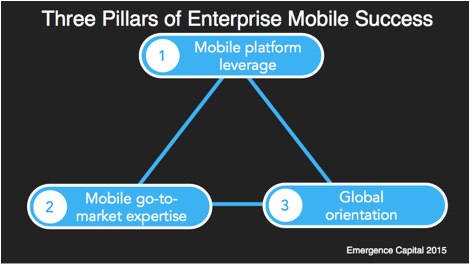
Enterprise mobile applications – like enterprise cloud applications a decade before – are poised to become a $100 billion market opportunity. I’ve worked with enterprise technologies exclusively for more than a decade and have watched as cloud apps took the enterprise by storm, giving businesses more flexibility and power than ever before. Now, enterprise mobile is taking a page from enterprise cloud’s play book – but with a twist.
Obviously, mobile technology is less expensive, more accessible, and easier to use in many ways than cloud technology, and that makes it attractive to the enterprise. But what may not be so obvious regarding the allure of mobile for the enterprise is the degree to which it will democratize the use of technology for businesses in underserved sectors and far-flung locations.
There are more than 3 billion people globally who work in some capacity. Yet only 20 percent of them have ever had access to technology to help them perform their jobs more effectively. That leaves 2.5 billion workers not being supported by technology today. Some of them are in industries like construction, an $8 trillion a year space that spends less than 1 percent of its revenue on IT. Others are in manufacturing, the world’s fourth-largest industry with 40 million workers globally — it spends less than 2 percent of revenue on IT.
A significant portion of those 2 billion-plus workers without technology are in the developing world, with 50 percent in Asia-Pacific, 10 percent in Latin America and another 10 percent in the Middle East and Africa. This global opportunity is enormous, and mobile technology is uniquely poised to capitalize on this market as the heavy infrastructure improvements necessary for hard-wired solutions are expensive and time consuming to deploy.
Overall, we’re talking about some pretty staggering numbers, but just how big is the mobile enterprise opportunity? Consider this quick calculation. If we take the 2.5 billion workers that don’t have desk jobs and assume we can monetize each one at about $40 per year (a mere 10 percent of what is spent today on technology for a typical desk-bound worker) we’re looking at approximately $100+ billion in annual revenue.
This opportunity is vast in many ways – and it is also unlike anything we’ve seen in enterprise technology in the past. Any industry that would benefit from the features that smartphones now have can leverage an enterprise mobile solution. Industries like construction and surveying can empower their mobile workforces with camera-based technology to get fast and cheap quotes and communication to their central offices. Delivery and transportation workers can utilize mapping, billing and other phone-enabled mobile solutions to achieve greater efficiency. Healthcare is likely the largest opportunity, in India, mobile healthcare apps are taking off. In fact, 500 Startups has launched a fund dedicated to investing in mobile health in India, China and Africa.
What will it take for entrepreneurs who want to seize this opportunity and build a leading mobile enterprise company? Here are a few best practices that I have seen in some of the early leaders:

In order to best leverage the mobile platform, capitalize on what is unique about mobile devices. Consider the following:
Use the latest smartphone capabilities (e.g. sensors, cameras, GPS, voice) to your advantage. Great examples are how Shyp uses your location and that of its networked “shippers” and how Expensify uses the camera features to capture receipts.
Consider how some of the leading mobile platform providers, like Box and Salesforce can help you as you scale.
Mobile go-to-market expertise
This is just as important in the mobile arena as it is in other spaces, but there are some interesting differences.
Learn how to successfully manage app store optimization for a business user or for a business-oriented company. Tools like SearchMan, apptamin and Sensor Tower can all help you achieve optimization without a lot of time or resources.
Build a customer acquisition model that matches your offering, for example, mobile messaging company Cotap, relies on enabling viral growth through its interface.
Leverage word-of-mouth in vertical markets. PlanGrid in the construction space has grown through their customers spreading the word.
Global orientation
Most mobile enterprise developers today are not thinking much about international coverage, which can put you at a competitive advantage. There is a much more significant international opportunity in the mobile space than even in the cloud or SaaS spaces. Map out your global ambitions in the earliest days of your company, and plan how you’ll actually embed that into your organization’s DNA.
Global planning can’t be an afterthought because 70 percent of the opportunities you will be pursuing are outside of developed markets.
Localize your product or make it easy to localize. It’s very costly to retrofit a product.
Think about mirroring best practices of SaaS companies that have expanded internationally, and how these same techniques translate to mobile.
Consider a range of international go-to-market strategies before committing to one. There are different paths to success – working with a partner to be distribution arm, building local teams/hubs in each region or market, acquiring a company in another region that is doing something similar and make that your expansion strategy – choose which strategy or combination of strategies makes the most sense for your product after you have fully evaluated each.
Once in a great while, a revolutionary technology and platform comes along; one that changes the game in the enterprise. I think we’re in the midst of just such a revolution. When we look back in 2025, it will be incredible to think that the mobile enterprise sector had less than $100 million of revenues just 10 years earlier.
Read the original post at Techcrunch.com
